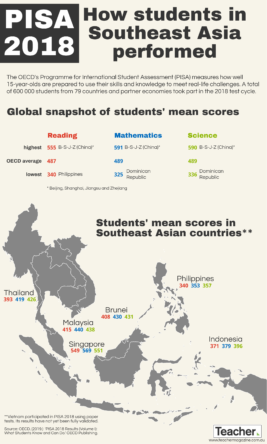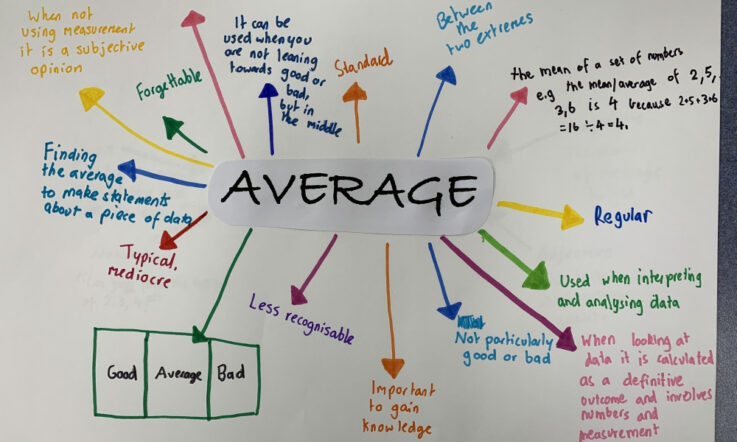Students in Singapore once again topped the international rankings in two key subjects. The Trends in International Mathematics and Science Study (TIMSS) assesses students in Grades 4 and 8, every four years. Here’s how Singapore and other countries in the region have performed in TIMSS, and how the scores relate to students’ knowledge and understanding.
More than 580 000 students from 64 countries and eight benchmarking systems participated in the 7th cycle of TIMSS in 2019. The results were released at the end of last year and, once again, it was a clean sweep for Singapore.
The top three performing countries in Grade 4 mathematics were: Singapore, where students achieved an average score of 625 points, Hong Kong (602 points) and Korea (600 points). In Grade 8 mathematics, Singapore performed the highest (616 points), followed by Chinese Taipei (612 points) and Korea (607 points).
In Grade 4 science, Singapore topped the list (595 points), followed by Korea (588 points) and Japan (562 points). And, in Grade 8 science, Singapore performed highest (608 points), followed by Chinese Taipei (574 points) and Japan (570 points).
A regional snapshot
Looking beyond Singapore to the rest of the region, Malaysia (Grade 8 maths and science) and the Philippines (Grade 4 maths and science) also participated in the 2019 assessment. Indonesia and Thailand have featured in previous TIMSS test cycles but did not participate this time around.
Malaysia has participated in the TIMSS Grade 8 assessments for the last six test cycles. This time, in Grade 8 mathematics, Malaysia ranked 28th with an average student score of 461 points; its students achieved a similar result in Grade 8 science, ranking 29th with an average score of 460 points.
Philippines participated in TIMSS for the first time since 2003. This time, the Philippines came bottom of the country rankings in both Grade 4 maths (297 points) and Grade 4 science (249 points) – although, both 2019 results include a note that there are reservations about data reliability ‘because the percentage of students with achievement too low for estimation exceeds 15 per cent but does not exceed 25 per cent’.
International benchmarks
The overall goal of TIMSS is to help improve maths and science teaching and learning. So, what do these scores mean in terms of students’ knowledge and understanding?
There are four international benchmarks along the TIMSS achievement scale: Advanced International Benchmark (625 points), High International Benchmark (550 points), Intermediate International Benchmark (475 points), and Low International Benchmark (400 points).
On average, students in the Philippines are below the low benchmark in Grade 4 maths – this first benchmark is the point at which students have some basic mathematical knowledge, including adding, subtracting, multiplying and dividing one- and two-digit whole numbers and read simple bar graphs and tables. At the other end of the scale, the average student in Singapore reached the advanced benchmark – knowledge and understanding here includes fractions and decimals, and solving multistep word problems with whole numbers.
In Grade 4 science again, on average, students in the Philippines are below the low benchmark – where students show limited understanding of scientific concepts and limited knowledge of foundational science facts.
In Malaysia, the average Grade 8 student passed the low benchmark in both maths and science but fell short of the intermediate international benchmark. The low benchmark in maths means students have some knowledge of whole numbers and basic graphs; in science they have limited understanding of scientific principles and concepts and limited knowledge of science facts. At the top of the rankings in Grade 8 maths and science, the average Singapore student passed the high benchmark – where they can apply their understanding and knowledge in a variety of relatively complex situations, including solving problems with fractions, decimals, ratios, and proportions; and apply understanding of concepts from biology, chemistry, physics, and Earth science.
Closing the gender gap
The latest TIMSS results reveal ‘Nearly half the countries had gender equity in average mathematics and science achievement. However, in mathematics, boys outperformed girls in nearly half the countries at the fourth grade. In science, girls outperformed boys in 18 countries at the fourth grade and 15 countries at the eighth grade.’
In the Philippines there was a big contrast between the performance of boys and girls. In Grade 4 mathematics, girls achieved an average score of 315 points and boys 280 points – the highest difference of any participating country. And it was a similar story in Grade 4 science, where girls achieved an average score of 261 points and boys 238 points.
In Grade 8 maths, in Singapore a gap favouring girls in the 2015 cycle was closed this time around. In Grade 8 science in Malaysia, although girls still outperformed boys 463 to 458, the gap was closed from 10 percentage points in 2015; in Grade 8 maths however, a similar gap exists between girls (465 points) and boys (456 points) in the 2019 results.
Stay tuned: In a follow-up article we’ll look at more information from TIMSS 2019, including school discipline and safety, teacher professional development needs, and challenges to teaching and learning in each country.
References
Mullis, I. V. S., Martin, M. O., Foy, P., Kelly, D. L., & Fishbein, B. (2020). TIMSS 2019 International Results in Mathematics and Science. Retrieved from Boston College, TIMSS & PIRLS International Study Center website https://timssandpirls.bc.edu/timss2019/international-results/
The full TIMSS report (https://timssandpirls.bc.edu/timss2019/) includes detailed information about each country’s performance, achievement by gender, descriptions of each benchmark and example items from the test.



